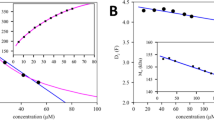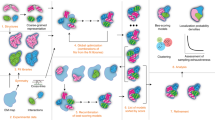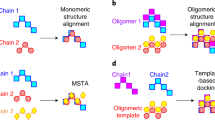Abstract
Molecular machines or macromolecular complexes are supramolecular assemblies of biomolecules with a variety of functions. Structure determination of these complexes in a purified state is often tedious owing to their compositional complexity and the associated relative structural instability. To improve the stability of macromolecular complexes in vitro, we present a generic method that optimizes the stability, homogeneity and solubility of macromolecular complexes by sparse-matrix screening of their thermal unfolding behavior in the presence of various buffers and small molecules. The method includes the automated analysis of thermal unfolding curves based on a biophysical unfolding model for complexes. We found that under stabilizing conditions, even large multicomponent complexes reveal an almost ideal two-state unfolding behavior. We envisage an improved biochemical understanding of purified macromolecules as well as a substantial boost in successful macromolecular complex structure determination by both X-ray crystallography and cryo-electron microscopy.
This is a preview of subscription content, access via your institution
Access options
Subscribe to this journal
Receive 12 print issues and online access
$259.00 per year
only $21.58 per issue
Buy this article
- Purchase on Springer Link
- Instant access to full article PDF
Prices may be subject to local taxes which are calculated during checkout




Similar content being viewed by others
References
Rigaut, G. et al. A generic protein purification method for protein complex characterization and proteome exploration. Nat. Biotechnol. 17, 1030–1032 (1999).
Berger, I., Fitzgerald, D.J. & Richmond, T.J. Baculovirus expression system for heterologous multiprotein complexes. Nat. Biotechnol. 22, 1583–1587 (2004).
Forler, D. et al. An efficient protein complex purification method for functional proteomics in higher eukaryotes. Nat. Biotechnol. 21, 89–92 (2003).
Gavin, A.C. et al. Proteome survey reveals modularity of the yeast cell machinery. Nature 440, 631–636 (2006).
Vijayachandran, L.S. et al. Robots, pipelines, polyproteins: enabling multiprotein expression in prokaryotic and eukaryotic cells. J. Struct. Biol. 175, 198–208 (2011).
Manjasetty, B.A., Turnbull, A.P., Panjikar, S., Bussow, K. & Chance, M.R. Automated technologies and novel techniques to accelerate protein crystallography for structural genomics. Proteomics 8, 612–625 (2008).
Bai, X.-C., McMullan, G. & Scheres, S.H.W. How cryo-EM is revolutionizing structural biology. Trends Biochem. Sci. 40, 49–57 (2015).
Cheng, Y. Single-particle cryo-EM at crystallographic resolution. Cell 161, 450–457 (2015).
Mueller, M., Jenni, S. & Ban, N. Strategies for crystallization and structure determination of very large macromolecular assemblies. Curr. Opin. Struct. Biol. 17, 572–579 (2007).
Boivin, S., Kozak, S. & Meijers, R. Optimization of protein purification and characterization using Thermofluor screens. Protein Expr. Purif. 91, 192–206 (2013).
Kopec, J. & Schneider, G. Comparison of fluorescence and light scattering based methods to assess formation and stability of protein–protein complexes. J. Struct. Biol. 175, 216–223 (2011).
Niesen, F.H., Berglund, H. & Vedadi, M. The use of differential scanning fluorimetry to detect ligand interactions that promote protein stability. Nat. Protoc. 2, 2212–2221 (2007).
Henry, A.J.M. & Meier, C. Thermofluur method. Patent application WO2010109204 A1 (2010).
Klotz, I.M. Comparison of molecular structures of proteins: helix content; distribution of apolar residues. Arch. Biochem. Biophys. 138, 704–706 (1970).
Rhodes, G. Crystallography Made Crystal Clear (Academic Press, 2002).
Chandrasekhar, K. et al. Active-site changes in the pyruvate dehydrogenase multienzyme complex E1 apoenzyme component from Escherichia coli observed at 2.32 Å resolution. Acta Crystallogr. D Biol. Crystallogr. 62, 1382–1386 (2006).
Bates, D.L., Danson, M.J., Hale, G., Hooper, E.A. & Perham, R.N. Self-assembly and catalytic activity of the pyruvate dehydrogenase multienzyme complex of Escherichia coli. Nature 268, 313–316 (1977).
Chari, A. et al. An assembly chaperone collaborates with the SMN complex to generate spliceosomal SnRNPs. Cell 135, 497–509 (2008).
Kim, Y.E., Hipp, M.S., Bracher, A., Hayer-Hartl, M. & Hartl, F.U. Molecular chaperone functions in protein folding and proteostasis. Annu. Rev. Biochem. 82, 323–355 (2013).
Lieb, B. et al. Red blood with blue-blood ancestry: intriguing structure of a snail hemoglobin. Proc. Natl. Acad. Sci. USA 103, 12011–12016 (2006).
Frye, J.J. et al. Electron microscopy structure of human APC/CCDH-1–EMI1 reveals multimodal mechanism of E3 ligase shutdown. Nat. Struct. Mol. Biol. 20, 827–835 (2013).
Gao, Y.G. et al. The structure of the ribosome with elongation factor G trapped in the posttranslocational state. Science 326, 694–699 (2009).
Davies, J.M., Brunger, A.T. & Weis, W.I. Improved structures of full-length p97, an AAA ATPase: implications for mechanisms of nucleotide-dependent conformational change. Structure 16, 715–726 (2008).
Zhang, R. et al. Structure of a key intermediate of the SMN complex reveals Gemin2's crucial function in snRNP assembly. Cell 146, 384–395 (2011).
Grimm, C. et al. Structural basis of assembly chaperone- mediated snRNP formation. Mol. Cell 49, 692–703 (2013).
Monecke, T. et al. Crystal structure of the nuclear export receptor CRM1 in complex with Snurportin1 and RanGTP. Science 324, 1087–1091 (2009).
Schröder-Tittmann, K. et al. Alternating sites reactivity is a common feature of thiamin diphosphate-dependent enzymes as evidenced by isothermal titration calorimetry studies of substrate binding. Biochemistry 52, 2505–2507 (2013).
Acknowledgements
We thank H. Oster and J. Barclay for providing access to their RT-PCR machine, and W. Liu for graphical design advice. Further we acknowledge the numerous groups that provided complexes for analysis. We also thank U. Steuerwald and J. Wawrzinek of the Crystallization Facility of the Max Planck Institute for Biophysical Chemistry for assistance in crystallization screening. We thank H.W. Rémigy (FEI company) for fruitful discussions. A. Buchberger (University of Würzburg) is acknowledged for the kind gift of p97 expression plasmids. The plasmid pGS523, which encodes the E1, E2 and E3 components of E. coli PDHc, was kindly provided by J. Guest (University of Sheffield). This work was supported by Deutsche Forschungsgemeinschaft SFB 860 (TP A05 to H.S.). A.C. is an associated member of SFB 860. This work was further funded by a DFG grant to A.C. (CH 1098/1-1) and an Instruct pilot project grant to H.S. and A.C., as part of the European Strategy Forum on research Infrastructures (ESFRI) and supported by national member subscriptions. D.H. is a recipient of a PhD scholarship from the Boehringer Ingelheim Fonds. D.H. was supported by the PhD program “Molecular Biology” – International Max Planck Research School at the Georg August University Göttingen.
Author information
Authors and Affiliations
Contributions
A.C. and H.S. designed research; A.C. and D.H. performed most experiments and data analysis with the support of J.O., E.P., O.G. and V.M.; D.H. derived the thermodynamic theory used for the analysis; J.-M.K. designed an analysis software and performed analysis of data; N.F., C.G., J.J.F., M.J., M.T. and G.P. performed further experiments; J.M., J.-M.P., B.A.S. and K.T. supervised research partially; initial experiments were performed in the lab of U.F.; A.C., D.H., J.-M.K. and H.S. analyzed the data and prepared the manuscript.
Corresponding authors
Ethics declarations
Competing interests
A.C., D.H., J.-M.K. and H.S. have filed a patent application (WO2013034160 A1: “Methods for analyzing biological macromolecular complexes and use thereof”) and are currently developing a relevant product in cooperation with FEI Company.
Integrated supplementary information
Supplementary Figure 1 Data analysis workflow.
First step: Identification of valid datasets. Amplitudes and number of valid maxima are investigated. If more than 6 local maxima are identified the curve is neglected. Second step: Background subtraction. The signal from both buffer references are averaged and subtracted from all individual curves in the dataset. Third step: Normalization. All datasets are normalized to a range of 0 to 1000, by setting the lowest local minimum to 0 and the highest relevant local maximum to 1000. Fourth step: Identification and removal of datasets containing air bubbles. The slope from the first data-point to the first relevant local minimum is evaluated. Curves with large slopes are omitted. This also removes transitions of proteins, which were already aggregated in solution prior to measurement. Fifth step: Data approximation according to the thermodynamic framework presented here for two- to five-state models. Sixth step: Parameter extraction for two-state and best fitting models. The values for Tm, ∆Hm, R² are extracted for the two-state model and the best fitting model. These extracted parameters are then hierarchically sorted to evaluate the most stabilizing conditions.
Supplementary Figure 2 Schematic representation of possible unfolding scenarios.
Schematic temperature vs. fluorescence curves are shown, with different colors representing three phases of the entire unfolding transition. The left white part represents the folded phase, the middle orange part the unfolding phase and the right white part the aggregation phase. The half-maximal intensity corresponding to the inflection point of the curve and thus the melting temperature is depicted as dotted line. The dashed line curve insets represent an idealized two state unfolding behavior, with a steep transition. Cartoons of the behavior of proteins are depicted below the graph. (a) A typical unfolding transition curve of a single domain protein is shown. Note, that it overlays well with the dashed line and therefore it is assumed to represent two-state unfolding. (b) The unfolding curve for an instable protein complex is shown. The complex disassembles before it unfolds, yielding multiple transitions and a considerable divergence from two-state unfolding. (c) The unfolding transition for another instable protein complex is shown. Disassembly and unfolding occur in a narrow temperature range yielding multiple transitions which superimpose in a way that they cannot be distinguished anymore. However, this yields a shallow transition in comparison to the dashed line curve (i.e. two-state unfolding). (d) The unfolding curve of a stable complex is shown. Disassembly and unfolding occur in a near concerted manner. Thus, the curve resembles the two-state transition shown in (a).
Supplementary Figure 3 Theoretical unfolding transition behaviors.
Temperature – fluorescence unfolding curves of a theoretical three-subunit complex are shown. Left: The single-transitions of the individual components are depicted. Right: Graphs depict a normalized sum of three individual curves. (a) The three components unfold independently from each other at different temperatures. The sum is a curve showing several independent transitions. (b) The components unfold at similar temperatures but still independently from each other. The resulting sum resembles a two-state unfolding curve. (c) The components unfold cooperatively at the same temperature. This also results in a two-state curve, which is steeper than in the middle case. However, the melting temperature of the shallower uncooperative unfolding transitions results in an apparently higher melting point Tm1, than the cooperative transition (Tm2) as visualized by the dotted lines.
Supplementary Figure 4 Evaluation of the quality of ProteoPlex data approximation.
Two experimental data curves exemplifying the curve fitting process are shown as blue dots. In DSF only the transition part of the data is fitted by a Boltzmann model as shown in yellow13. The best data approximation from ProteoPlex is shown in green. While Boltzmann data approximation still gives acceptable results for a near two-state unfolding behavior (left), multiple transitions cannot be approximated by a simple Boltzmann model (right). In contrast, ProteoPlex still describes the obtained curve well. Of note: The ProteoPlex model is able to fit the whole curve and thus will obtain more accurate parameters.
Supplementary Figure 5 Screening for additives.
Analysis of Biomphalaria glabrata hemoglobin complex (BgHb, 1.5 MDa native molecular weight) – a protein of unknown structure. Under standard purification conditions BgHb is mostly present as aggregated particles in negatively stained EM images (left panel, scale bar = 50 nm). The upper pane of the middle panel depicts a subset of unfolding transitions from a ProteoPlex pH screen. The stability of BgHb is gradually increased from alkaline to acidic Imidazole buffer conditions, with a final enhanced stabilization of 45 K at pH 5.8 compared to pH 8.2. The lower pane of the middle panel reveals that interpretable unfolding transitions of the complex only occurs in Imidazole buffer, which suggests the role of Imidazole additionally as a stabilizing ligand. In Imidazole pH 5.8, negatively stained EM analysis reveals a monodisperse field of compact particles (right panel, scale bar 50 nm).
Supplementary Figure 6 Finding optimal conditions for reconstitution experiments.
(a) Reconstitution of PDHc from individually purified subunits (E1, E2, E3). A constant concentration of the core E2 component was mixed with increasing amounts of E1 along the y-axis and increasing E3 amounts along the x-axis (5, 4 and 2.5, 1.5, 1, 0.5, 0.25 and 0.125 fold molar excess of E2 subunit) and assayed with ProteoPlex. Experimental curves (blue dots) and fits (green) from the screen (middle) show two-state unfolding behavior in the case of a high excess of E1 over E2 and low amounts of E3 and mono-disperse, compact particles in EM images (right panel). Whereas, low amounts of E1 and E3 in comparison to E2 yields polyphasic transitions and aggregated particles (left panel).The scalebar corresponds to 50 nm in the EM images. (b) SDS-PAGE of the peak fractions of the reconstituted sample and a sample purified from native source are shown. Asterisks denote impurities in the sample purified from native source. Note the stoichiometry of both samples agree well with each other.
Supplementary Figure 7 Automation.
(a) The robotic platform consists of a liquid handling system a plate sealing device and a RT-PCR machine. The setup allows full automation of liquid handling, thermal melt measurement and data evaluation. (b) Reproducibility tests using manual (top panel) and robotic pipetting (lower panel) of 96 identical conditions. The robotic liquid handling reveals a significant increase in reproducibility as shown by an almost perfect overlay of the normalized curves.
Supplementary Figure 8 Test of different real-time PCR (RT-PCR) machines.
Two of the most commonly used RT-PCR machines were tested towards their applicability with ProteoPlex: the ABI Via7 and the Bio-Rad CFX connect. First the background signal was analyzed. While it was uniform for the Bio-Rad machine (upper row, right panel), strong discrepancies could be seen for the ABI device. A very similar result can be seen by just measuring Sypro Orange diluted to the concentration used for screening (second row). Lastly the machines were tested with Lysozyme and the amplitude of the noise as well of the protein in optimal concentration was measured. A simple SNR was estimated by dividing these two amplitudes. The Bio-Rad machine reaches a SNR that is twice higher than the Via7.
Supplementary information
Supplementary Text and Figures
Supplementary Figures 1–8, Supplementary Tables 1–4 and Supplementary Note (PDF 2693 kb)
Source data
Rights and permissions
About this article
Cite this article
Chari, A., Haselbach, D., Kirves, JM. et al. ProteoPlex: stability optimization of macromolecular complexes by sparse-matrix screening of chemical space. Nat Methods 12, 859–865 (2015). https://doi.org/10.1038/nmeth.3493
Received:
Accepted:
Published:
Issue Date:
DOI: https://doi.org/10.1038/nmeth.3493
This article is cited by
-
Protein purification strategies must consider downstream applications and individual biological characteristics
Microbial Cell Factories (2022)
-
Assembly defects of human tRNA splicing endonuclease contribute to impaired pre-tRNA processing in pontocerebellar hypoplasia
Nature Communications (2021)
-
Quantifying the heterogeneity of macromolecular machines by mass photometry
Nature Communications (2020)
-
Cryo-EM analysis of homodimeric full-length LRRK2 and LRRK1 protein complexes
Scientific Reports (2017)
-
How good can cryo-EM become?
Nature Methods (2016)



